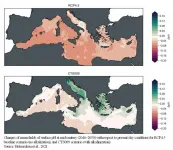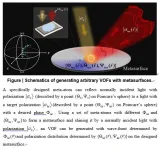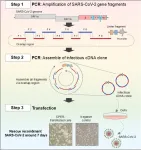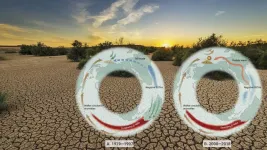INFORMATION:
New advice for medics treating high blood pressure
National University of Ireland Galway discovery on silent killer condition could profoundly change care for patients
2021-04-13
(Press-News.org) New research led by a professor at NUI Galway is set to change how doctors treat some patients with high blood pressure - a condition that affects more than one in four men and one in five women.
The study by researchers at NUI Galway, Johns Hopkins University and Harvard Medical School found no evidence that diastolic blood pressure - the bottom reading on a blood pressure test - can be harmful to patients when reduced to levels that were previously considered to be too low.
Lead researcher Bill McEvoy, Professor of Preventive Cardiology at NUI Galway and a Consultant Cardiologist at University Hospital Galway, said the findings have the potential to immediately influence the clinical care of patients.
Professor McEvoy said: "We now have detailed research based on genetics that provides doctors with much-needed clarity on how to treat patients who have a pattern of high systolic values - the top reading for blood pressure - but low values for the diastolic, or bottom, reading.
"This type of blood pressure pattern is often seen in older adults. Old studies using less reliable research methods suggested that the risk for a heart attack began to increase when diastolic blood pressure was below 70 or above 90. Therefore, it was presumed there was a sweet-spot for the diastolic reading."
High blood pressure is a major cause of premature death worldwide, with more than 1 billion people having the condition. It is linked with brain, kidney and other diseases, but it is best known as a risk factor for heart attack. More recently, high blood pressure has emerged as one of the major underlying conditions that increase the risk of poor outcomes for people who become infected with Covid-19.
Professor McEvoy and the international research team analysed genetic and survival data from more than 47,000 patients worldwide. The study, published in the prestigious medical journal Circulation, showed:
There appears to be no lower limit of normal for diastolic blood pressure and no evidence in this genetic analysis that diastolic blood pressure can be too low.
There was no genetic evidence of increased risk of heart disease when a patient's diastolic blood pressure reading is as low as 50.
The authors also confirmed that values of the top, systolic, blood pressure reading above 120 increased the risk of heart disease and stroke.
Blood pressure medications reduce both systolic and diastolic values.
Professor McEvoy added: "Because doctors often focus on keeping the bottom blood pressure reading in the 70-90 range, they may have been undertreating some adults with persistently high systolic blood pressure.
"The findings of this study free up doctors to treat the systolic value when it is elevated and to not worry about the diastolic blood pressure falling too low.
"My advice now to GPs is to treat their patients with high blood pressure to a systolic level of between 100-130mmHg, where possible and without side effects, and to not worry about the diastolic blood pressure value."
Dr Joe Gallagher, Irish College of General Practioners' Lead, National Heart Programme, said: "This data helps remove uncertainty about how to treat people who have an elevated systolic blood pressure but low diastolic blood pressure. This is a common clinical problem which causes much debate. It will help impact clinical practice internationally and shows the importance of Irish researchers in clinical research."
The research team used new technologies to take into account genetic information that is unbiased, which was not the case with prior observational studies. They assessed data from 47,407 patients in five groups with a median age of 60.
ELSE PRESS RELEASES FROM THIS DATE:
National narcissists likely to support greenwashing campaigns to improve nation's image
2021-04-13
New research by the University of Kent and the SWPS University has discovered that national narcissists are more likely to support greenwashing (misleading information about the environmental benefits of a product, a company or a policy) in order to improve their nation's public image.
Findings show that while national narcissists are not likely to support genuine pro-environmental campaigns, they are ready to support political greenwashing campaigns. In business greenwashing decreases consumers' trust and undermines both the image and the profits of the companies that use this strategy. In the realms of politics, it may garner ...
Reducing ocean acidification by removing CO2: Two targets for cutting-edge research
2021-04-13
Is it possible to simultaneously address the increase of the concentration of carbon dioxide (CO2) in the atmosphere and the resulting acidification of the oceans? The research of the project DESARC-MARESANUS, a collaboration between the Politecnico di Milano and the CMCC Euro-Mediterranean Center on Climate Change Foundation, explores the feasibility of this process, its chemical and environmental balance, and the benefits for the marine sector, focusing on the Mediterranean basin.
It is now widely recognized that in order to reach the target of limiting global warming ...
Study shows multiple factors shape timing of birth in mule deer
2021-04-13
A five-year study of mule deer does and newborn fawns in western Wyoming shows that migrating deer have a lot to balance when it comes to birth timing.
The study led by University of Wyoming scientists challenges the long-held assumption that animals match offspring birth with the peak green-up of forage at the birth site. Instead, only deer that migrated long distances and followed the flush of spring green-up from low elevation winter ranges to higher-elevation summer ranges were able to match birth with peak green-up. Other deer migrated shorter distances and gave birth earlier, but birth was out of sync with green-up.
The researchers' work appears in the journal Ecology.
To ...
Efficient generations of complex vectorial optical fields with metasurfaces
2021-04-13
Light beams are widely used in photonics applications and attracted immense research interests. Compared to homogeneously polarized light beams, vectorial optical fields (VOFs) with tailored wave-fronts and inhomogeneous polarization distributions exhibits more advantages in applications comparing to their scalar-wave counterparts, thanks to the added degree of freedom (DOF) of polarization. By tailoring the polarization distributions, special VOFs such as flap-top beams and radially polarized beams can be generated, being highly favored in super-resolution microscopy, optical manipulations, etc.
Despite of great advances in applications, generation of such complex VOFs are far from satisfactory. Available methods ...
SUTD breaks new ground in 3D printed soft robotics with largest range of polymer hybrids
2021-04-13
In a study published in Applied Materials Today, researchers from Singapore have developed the largest range of silicone and epoxy hybrid resins for the 3D printing of wearable devices, biomedical equipment, and soft robotics. The range of tunable functionally graded materials, which displayed over five orders of magnitude of elastic modulus, demonstrated excellent interfacial toughness, higher precision in complex structures and better fabrication control for the integration of mechatronic components.
The multi-disciplinary team from the Singapore University of Technology and Design (SUTD) highlighted the issue on the potential of soft robotics being limited in its robustness and ...
A novel, quick, and easy system for genetic analysis of SARS-CoV-2
2021-04-13
Osaka, Japan - SARS-CoV-2 is the virus responsible for the COVID-19 pandemic. We know that mutations in the genome of SARS-CoV-2 have occurred and spread, but what effect do those mutations have? Current methods for studying mutations in the SARS-CoV-2 genome are very complicated and time-consuming because coronaviruses have large genomes, but now a team from Osaka University and Hokkaido University have developed a quick, PCR-based reverse genetics system for analyzing SARS-CoV-2 mutations.
This system uses the polymerase chain reaction (PCR) and a circular polymerase extension reaction (CPER) to reconstruct the full-length cDNA of viral genome. This process does not involve the use of bacteria, which can introduce further ...
The relationship between ENSO and Indian summer monsoon rainfall is restoring
2021-04-13
In the 1930s, English climatologist, Sir Gilbert Walker, successfully predicted Indian summer monsoon rainfall (ISMR) based on the relationship between Southern Oscillation and ISMR connected by what is later-called Walker circulation, which is regarded as the first achievement of modern climate prediction with a clear physical mechanism. The Southern Oscillation was also recognized as the atmospheric component of El Nino-Southern Oscillation (ENSO).
However, at the end of the 20th century, a research in Science led by Indian climatologist Krishna Kumar found the significant reverse relationship between ENSO and Indian rainfall has been ...
Abandoning the old ways: Progress in the low-cost electrochemical synthesis of ammonia
2021-04-13
Ammonia (NH3) is among the most important chemicals produced by humans and has a promising future in sustainable energy applications besides being used in fertilizer production. Unfortunately, so far, the only realistic way that exists to produce ammonia at an industrial scale is through the Haber-Bosch process. This technique, discovered in the 19th century, is very energy-intensive and environmentally unfriendly; about 2% of the yearly global CO2 emissions come from Haber-Bosch processes.
"Considering the threats posed by global warming, it is high time we swap to an ammonia synthesis route with zero CO2 emissions," says Professor Sangaraju Shanmugam from Daegu Gyeongbuk Institute of Science and Technology (DGIST), Korea. ...
Student's second-year homework picked up by Amazon quantum researchers
2021-04-13
What started out as a second-year physics project is making its way into Amazon Web Service's (AWS) quantum computing program.
University of Sydney science undergraduate Pablo Bonilla Ataides has tweaked some computing code to effectively double its capacity to correct errors in the quantum machines being designed in the emerging technology sector.
The simple but ingenious change to quantum error correcting code has grabbed the attention of quantum researchers at the AWS Center for Quantum Computing in Pasadena, California, and the quantum technology programs at Yale University and Duke University in the United States.
"Quantum technology is in its infancy, partly because we haven't ...
Partial shade from solar panels increase abundance of flowers in late summer
2021-04-13
CORVALLIS, Ore. - A new study by Oregon State University researchers found that shade provided by solar panels increased the abundance of flowers under the panels and delayed the timing of their bloom, both findings that could aid the agricultural community.
The study, believed to be the first that looked at the impact of solar panels on flowering plants and insects, has important implications for solar developers who manage the land under solar panels, as well as agriculture and pollinator health advocates who are seeking land for pollinator habitat restoration.
The findings, ...
LAST 30 PRESS RELEASES:
Manta rays create mobile ecosystems, study finds
Study: Mixed results in using lipoic acid to treat progressive multiple sclerosis
Norbert Holtkamp appointed director of Fermi National Accelerator Laboratory
New agentic AI platform accelerates advanced optics design
Biologists discover neurons use physical signals — not electricity — to stabilize communication
Researchers discover that a hormone can access the brain by hitchhiking
University of Oklahoma researcher awarded funding to pursue AI-powered material design
Exploring how the visual system recovers following injury
Support for parents with infants at pediatric check-ups leads to better reading and math skills in elementary school
Kids’ behavioral health is a growing share of family health costs
Day & night: Cancer disrupts the brain’s natural rhythm
COVID-19 vaccination significantly reduces risk to pregnant women and baby
The role of vaccination in maternal and perinatal outcomes associated with COVID-19 in pregnancy
Mayo Clinic smartwatch system helps parents shorten and defuse children's severe tantrums early
Behavioral health spending spikes to 40% of all children’s health expenditures, nearly doubling in a decade
Digital cognitive behavioral treatment for generalized anxiety disorder
Expenditures for pediatric behavioral health care over time and estimated family financial burden
Air conditioning in nursing homes and mortality during extreme heat
The Alps to lose a record number of glaciers in the next decade
What makes a good proton conductor?
New science reporting guide published for journalists in Bulgaria
New international study reveals major survival gaps among children with cancer
New science reporting guide published for journalists in Turkey
Scientists develop a smarter mRNA therapy that knows which cells to target
Neuroanatomy-informed brain–machine hybrid intelligence for robust acoustic target detection
Eight SwRI hydrogen projects funded by ENERGYWERX
The Lundquist Institute and its start-up company Vitalex Biosciences Announces Strategic Advancement of Second-Generation fungal Vaccine VXV-01 through Phase 1 Trials under $40 Million Competitive Con
Fine particles in pollution are associated with early signs of autoimmune disease
Review article | Towards a Global Ground-Based Earth Observatory (GGBEO): Leveraging existing systems and networks
Penn and UMich create world’s smallest programmable, autonomous robots
[Press-News.org] New advice for medics treating high blood pressureNational University of Ireland Galway discovery on silent killer condition could profoundly change care for patients







